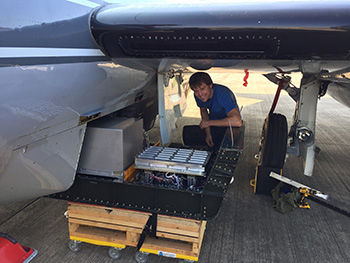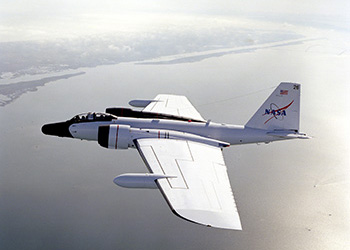A .gov website belongs to an official government organization in the United States.
A lock () or https:// means you've safely connected to the .gov website. Share sensitive information only on official, secure websites.
3 May 2017
adapted from the story by NOAA Communications

Sulfur dioxide released from volcanoes or power plants causes acid rain and leads to particles that play a role in breaking down the protective ozone layer high in the atmosphere. But those particles also reflect sunlight away from Earth, leading some to propose that people could inject sulfur dioxide (SO2) high in the atmosphere to mitigate global warming. New research in Geophysical Research Letters provides the first actual measurements of the chemical, SO2, in the tropical upper troposphere/lower stratosphere – and there's a whole lot less than some scientists estimated.
"These new data will be important for improving climate models, evaluating satellite data, and understanding the potential of climate intervention scenarios," said lead author Andrew Rollins, a scientist with the Cooperative Institute for Research in Environmental Sciences (CIRES) at the University of Colorado Boulder who works at NOAA ESRL CSD.
Scientists often use field missions to independently confirm or validate accuracy of satellite-based data. The NOAA-funded Volcano-plume Investigation Readiness and Gas-phase and Aerosol Sulfur (VIRGAS) mission, was important in that it determined that satellite-based estimates of the chemical and its impact on stratospheric aerosol were far too high, according to Rollins and his colleagues.
The team used a NASA WB-57 high altitude research aircraft to collect SO2 and other data from near the surface to nearly 12 miles high in the atmosphere. Sulfur dioxide was a focus because the chemical plays a principal role in connecting natural and human emissions of sulfur to major environmental issues such stratospheric aerosol formation and effects on climate.

Scientists have been especially eager to understand the role of tropospheric or low-level SO2, emitted from the Earth's surface, in maintaining background amounts of higher-level or stratospheric aerosols. There, particles serve to cool the planet by reflecting away sunlight, but they can also play a role in the destruction of ozone. Stratospheric ozone absorbs some of the ultraviolet radiation from the Sun, protecting Earth's surface from harmful amounts that cause skin cancer and damage crops.
During VIRGAS, Rollins and his colleagues installed their instruments on the NASA aircraft to make the first in-situ measurements of sulfur dioxide in the tropical upper tropopause and lower stratosphere. Then, the team used those measurements to evaluate climate models and satellite data. They also used data collected during the mission to understand how much stratospheric aerosol could actually be formed by SO2 transported from the troposphere.
Together, these analyses show that background levels of SO2 are about five times smaller than suggested by satellite observations – including satellite data that have been used to calculate the role of tropospheric SO2 in stratospheric aerosol formation. This shifts the view of sulfur dioxide as a dominant source of stratospheric aerosols to a near-negligible one, said co-author Karen Rosenlof, a NOAA ESRL CSD scientist, and it reveals a significant gap in scientists' understanding of the stratospheric aerosols budget.
"Knowing which models correctly simulate observed SO2 in the lower stratosphere gives us a greater ability to both project the future of the stratospheric aerosol layer and estimate the impact of proposed climate change mitigation strategies," Rosenlof said.
Some proposals suggest direct injection of SO2 into the lower stratosphere could be used to mitigate global warming. The new measurements provide a benchmark that can build confidence in scientists' understanding of sulfur chemistry in the upper troposphere and lower stratosphere, the new paper concludes. Now, the new information can be used to test models and satellite data that may be used in the future, to evaluate climate intervention scenarios.
Rollins, A.W., T.D. Thornberry, L.A. Watts, P. Yu, K. Rosenlof, M. Mills, E. Baumann, F.R. Giorgetta, T.V. Bui, M. Höpfner, K.A. Walker, C. Boone, P.F. Bernath, P.R. Colarco, P.A. Newman, D.W. Fahey, and R.S. Gao, The role of sulfur dioxide in stratospheric aerosol formation evaluated using in-situ measurements in the tropical lower stratosphere, Geophysical Research Letters, doi:10.1002/2017GL072754, 2017.
Stratospheric aerosols (SAs) are a variable component of the Earth's albedo that may be intentionally enhanced in the future to offset greenhouse gases (geoengineering). The role of tropospheric-sourced sulfur dioxide (SO2) in maintaining background SAs has been debated for decades without in-situ measurements of SO2 at the tropical tropopause to inform this issue. Here we clarify the role of SO2 in maintaining SAs by using new in-situ SO2 measurements to evaluate climate models and satellite retrievals. We then use the observed tropical tropopause SO2 mixing ratios to estimate the global flux of SO2 across the tropical tropopause. These analyses show that the tropopause background SO2 is about 5 times smaller than reported by the average satellite observations that have been used recently to test atmospheric models. This shifts the view of SO2 as a dominant source of SAs to a near-negligible one, possibly revealing a significant gap in the SA budget.